Supplemental Supporting Statement Part A for Substantive Changes June 2021
0218 - Supplemental Supporting Statement A for ARMS & Chemical Use Surveys - June 2021.docx
Agricultural Resource Management and Chemical Use Surveys
Supplemental Supporting Statement Part A for Substantive Changes June 2021
OMB: 0535-0218
SUPPLEMENTAL SUPPORTING STATEMENT Part A
ARMS 1, ARMS 2, ARMS 3, Fruit Chemical Use Survey and State Cooperative Surveys
Substantive Change
OMB No. 0535-0218
This substantive change is being submitted as a supplemental supporting statement to the Agricultural Resource Management Surveys (ARMS), the Fruit Chemical Use Survey, and State Cooperative Chemical Use Surveys.
A. JUSTIFICATION
Circumstances making collection of information necessary.
NASS is requesting a substantive change to the ARMS and Chemical Use Survey docket (0535-0218) to accommodate changes to several of the ARMS and Chemical Use surveys along with the addition of one chemical use survey done under a cooperative agreement with the state of Minnesota.
NASS conducts the ARMS program as a part of a cooperative agreement with the USDA Economic Research Service (ERS). In addition, the USDA Office of Pest Management Policy (OPMP) has provided input on the ARMS 2 (chemical use survey) as well as the Fruit and Vegetable Chemical Use Surveys. The Costs and Returns (Phase 3) surveys collect both whole farm data and commodity specific data. The whole farm data can be linked to the cropping practices and chemical use data collected in the ARMS 2 phase. The majority of the questions that are asked in the Phase 3 surveys are a part of the ARMS core program and rarely have any changes made to them. The cooperative agreement allows ERS to ask additional research questions each year to address changes in the farming industry. The OMB approval process is for a three-year period, so NASS projects ahead with the surveys and commodities that will be targeted for the next three years. Each year NASS will provide changes to the questionnaires to OMB for approval. Attached to this submission are listings of the changes made to the questionnaires conducted in 2021.
Historically, the majority of the surveys that are conducted under this OMB approval have been conducted by personal interviews. However, due to the pandemic, NASS has made changes to our data collection efforts to accommodate social distancing. NASS uses the National Association of State Department of Agriculture (NASDA) enumerators to collect the data. The surveys have been changed to allow for data collection by computer assisted web interviews (CAWI) and computer assisted telephone interviews (CATI). Due to these changes the ARMS 2 and ARMS 3 surveys that targeted corn and rice were not conducted in 2020 and have been moved to 2021. Changes that are being made to the ARMS 2 questionnaires are itemized in attached documents.
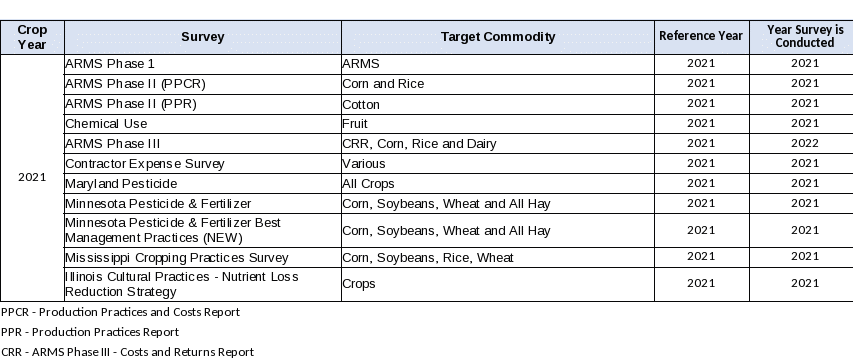
In addition, the Best Management Practices survey which is conducted through a cooperative agreement with the Minnesota State Department of Agriculture is being added to this approval.
The objective is to understand the recording and decision making process with regard to fertilizer and pesticide use. Data collected will cover the following topics: how fertilizer use is recorded, application strategies, practices to reduce nitrogen loss from fields, source of pesticide data considered for decision making, and who makes decisions on pesticide use.
This project is requested by the Minnesota Department of Agriculture to fulfill its mission under MN Statute 103H.151 where the MDA is required to monitor the effectiveness of Best Management Practices (BMPs) developed by the Department. This survey series is the monitoring method.
Farmers are direct beneficiaries of the results of this survey. These data allow the MDA staff to promote the voluntary nature of the BMPs by demonstrating the adoption levels and practices farmers are using have remained consistent with the BMP guidelines. This has avoided the need for any mandatory restrictions on chemical use and/or practices.
Also, minor changes will be made to the Fruit Chemical Use Survey, Illinois Nutrient Loss Reduction Strategy Survey, and the Minnesota Pesticide and Fertilizer surveys, these changes are itemized in attached documents.
How, by whom, and for what purpose information is to be used.
In addition to the long list of data users of the ARMS and chemical use data that was provided in the original approval, the Office of Pest Management Practice (OPMP), the Economic Research Service (ERS), and the State cooperators will be able to better address changes in the farming practices that have occurred since the original approval of this docket.
The Integrated Pest Management (IPM) questions will fulfill multiple needs by the Minnesota Department of Agriculture (MDA). The MDA is required by an executive order to educate and inform Minnesotans on the use of pesticides judiciously by using IPM. The questions will help us to develop a baseline of the understanding and implementation of IPM in Minnesota. In addition, the best management practices for pesticides include instructions on utilizing IPM in order to control pests. The information gathered through these survey questions will further our understanding on the extent of IPM adoption to control pests in the state.
In addition, the new Best Management Practices survey conducted in Minnesota, will target agricultural operations in Minnesota that grow corn or soybeans. According to the 2017 Census of Agriculture, there are an estimated 28,086 farms that grow corn for grain and 27,865 soybean farms in Minnesota. Each selected farmer or rancher will be asked to provide data on
How fertilizer use is recorded for the operation,
Fertilizer application strategies for the operation,
Practices to reduce nitrogen loss from fields for the operation,
Source of pesticide data considered for decision making, as well as
Who makes decisions on pesticide usage.
The information that will be summarized and published will include summary statistics for the questions asked. It is hoped that enough data will be collected to allow publishing of this data by Minnesota Department of Agriculture’s Pesticide Management Areas (PMA), and Nitrogen Best Management Practices (BMP).
Use of improved information technology.
The ARMS 2, Fruit Chemical Use Surveys, and cooperator surveys are done by mail, phone and field enumeration. These changes to the questionnaire’s content will not change anything as far as use of technology from what was previously approved. The ARMS 3 surveys are available by internet, mail, phone, and field enumeration.
4. Efforts to identify duplication.
There are no changes from the original approval related to duplication reduction.
Methods to minimize burden of small businesses.
With the use of the CATI and CAWI instruments, the incorporated screening questions and skip patterns should help minimize burden as much as possible. The number of small operations will remain at approximately 85% of the total sample size.
Consequence if information collection were less frequent.
There are no changes to the frequency of these surveys than was originally approved.
The new BMP survey will be conducted annually. The objective is to understand the recording and decision making process with regard to fertilizer and pesticide use. Data collected will cover the following topics: how fertilizer use is recorded, application strategies, practices to reduce nitrogen loss from fields, source of pesticide data considered for decision making, and who makes decisions on pesticide use.
Farmers are direct beneficiaries of the results of this survey. These data allow the MDA staff to promote the voluntary nature of the BMPs by demonstrating the adoption levels and practices farmers are using have remained consistent with the BMP guidelines. This has avoided the need for any mandatory restrictions on chemical use and/or practices.
Special circumstances.
No special circumstances are associated with this information collection.
Federal register notice and consultation with outside persons.
Additional contacts include:
For the Illinois Nutrient Loss Reduction Strategy Survey -
Julie Hewitt
Executive Director,
Illinois Nutrient Research and Education Council
Julie (Armstrong) Hewitt [email protected]
Lauren Lurkins
Illinois Farm Bureau
Jeff Kirwan
Chairman,
Illinois Nutrient Research and Education Council Board of Directors
Jeff KIrwan [email protected]
For the Minnesota Best Management Practices Survey –
The Corn Herbicide Management questions will fulfill multiple needs by the Minnesota Department of Agriculture (MDA). The MDA is required by statute and MN pesticide Management Plan to develop voluntary pesticide-specific Best Management Practices (BMPs) to prevent or minimize pollution, to the extent practicable, for pesticides that are designated as “common detection pesticides” in groundwater and “surface water pesticides of concern” in surface waters. These questions will assist the MDA in assessing the adoption of the BMP’s and provide direction on where additional education may be needed.
Denton Bruening
Minnesota Department of Agriculture
Cell: 651-261-1993
Office: 651-201-6399
Payments or gifts to respondents.
No payments or gifts will be given to respondents.
Confidentiality provided to respondents.
Questionnaires include a statement that individual reports are confidential. U.S. Code Title 18, Section 1905; U.S. Code Title 7, Section 2276; and Title III of Pub. L. No. 115-435 (CIPSEA) provide for confidentiality of reported information. All employees of NASS and all enumerators hired and supervised under a cooperative agreement with the National Association of State Departments of Agriculture (NASDA) must read the regulations and sign a statement of compliance.
Additionally, NASS employees and NASS contractors comply with the OMB implementation guidance document, “Implementation Guidance for Confidential Information Protection and Statistical Efficiency Act of 2018, Title III of Pub. L. No. 115-435, codified in 44 U.S.C. Ch. 35” CIPSEA supports NASS’s pledge of confidentiality to all respondents and facilitates the agency’s efforts to reduce burden by supporting statistical activities of collaborative agencies through designation of NASS agents, subject to the limitations and penalties described in CIPSEA.
The following confidentiality pledge statement will appear on all NASS questionnaires.
The information you provide will be used for statistical purposes only. Your responses will be kept confidential and any person who willfully discloses ANY identifiable information about you or your operation is subject to a jail term, a fine, or both. This survey is conducted in accordance with the Confidential Information Protection and Statistical Efficiency Act of 2018, Title III of Pub. L. No. 115-435, codified in 44 U.S.C. Ch. 35 and other applicable Federal laws. For more information on how we protect your information please visit: https://www.nass.usda.gov/confidentiality. Response to this survey is voluntary.
Questions of a sensitive nature.
No questions of sensitive nature will be asked.
12. Hour burden and annualized costs to respondents.
The following table contains the estimated burden hours for the surveys included in this supplemental supporting statement. Cost to the public for completing the questionnaire is assumed to be comparable to the hourly rate of those requesting the data. The adjusted overall cost to the public is estimated at $4,467,011.16.
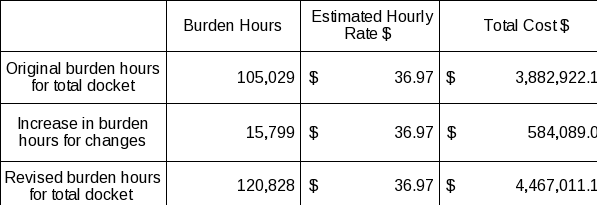
NASS uses the Bureau of Labor Statistics’ Occupational Employment Statistics (most recently published on March 31, 2021 for the previous May) to estimate an hourly wage for the burden cost. The May 2020 mean wage for bookkeepers was $21.20. The mean wage for farm managers was $36.93. The mean wage for farm supervisors was $25.25. The mean wage of the three is $27.79. To calculate the fully loaded wage rate (includes allowances for Social Security, insurance, etc.) NASS will add 33% for a total of $36.97 per hour.
Revisions for 2021 – sheet 1

Revisions for 2021 – sheet 2
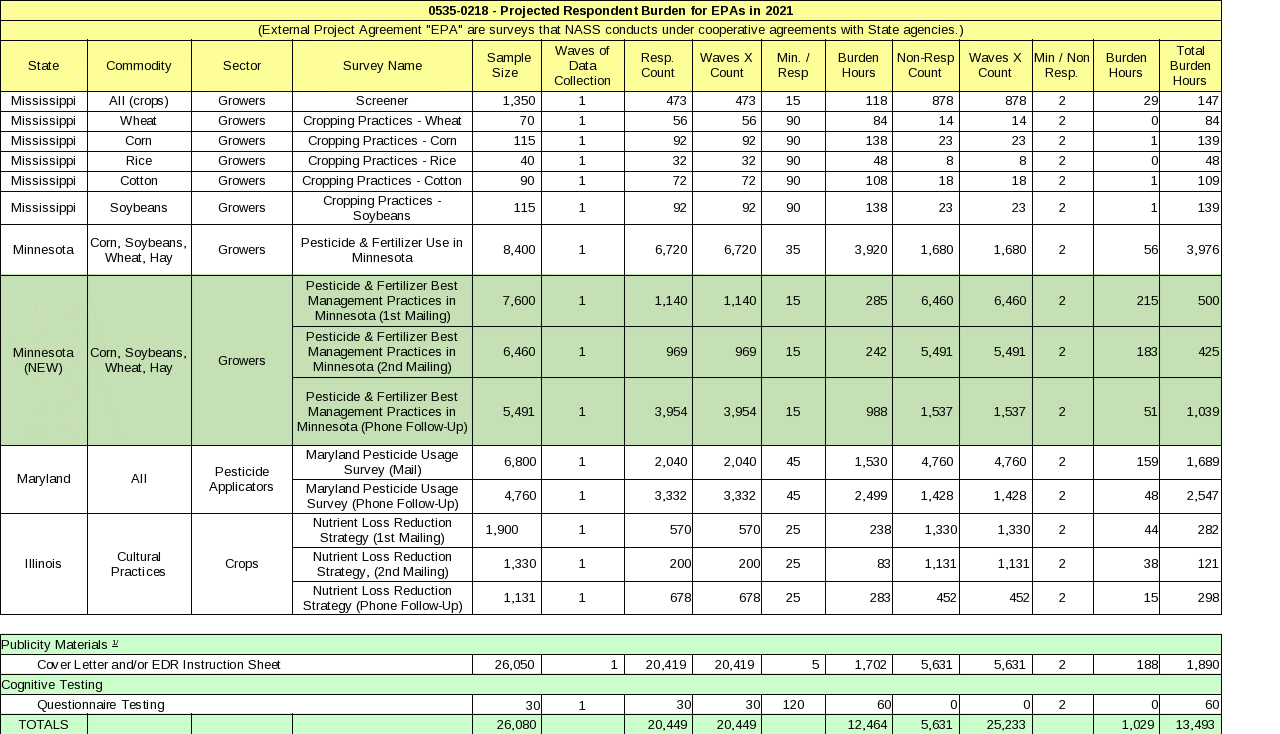
Revisions for 2020 - sheet 3
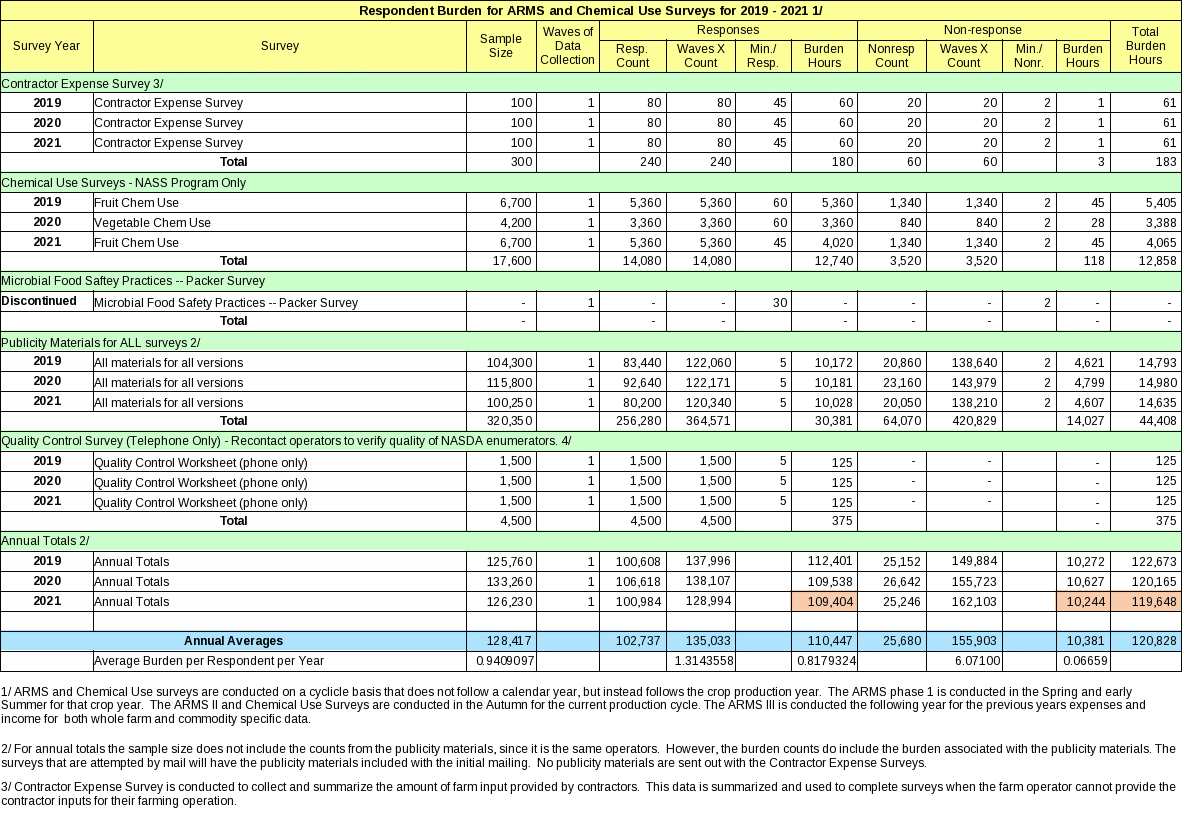
Total annual cost burden to respondents.
No start-up or ongoing operation/maintenance costs are associated with this information collection.
Annualized costs to federal government.
There are no changes to the total annual cost of $18 million for the Agricultural Resource Management Surveys and the Chemical Use programs as a result of these changes.
The projected annual cost to conduct the Best Management Practices Survey is approximately $65,800, most of which is staff costs. The costs will be reimbursed by the Minnesota Department of Agriculture. There will be no cost to the Federal government for this new survey.
Reasons for changes in burden.
Due to the COVID-19 pandemic and the need for social distancing, NASS and our enumerators have had to alter the modes of data collection to begin using internet responses and an increase in data collection by telephone. With the anticipated decrease in response rates, NASS and ERS postponed the ARMS 2 and ARMS 3 corn and rice versions until 2021 and concentrated our data collection efforts on the remaining surveys. The sample sizes and respondent burden have been adjusted to account for these program changes. Several questionnaire changes were made to the ARMS 2 and ARMS 3 surveys.
The cooperative agreement with the Minnesota Department of Agriculture added a new survey to collect Best Management Practices data, along with some minor modifications to the Pesticide and Fertilizer Use survey.
Finally, the Fruit Chemical Use survey had several pest management practices, questions removed this year.
Detailed listings of the questions added and deleted are attached to this submission.
There is an adjustment to respondent burden associated with publicity materials, due to a miscalculation in the previous submission.
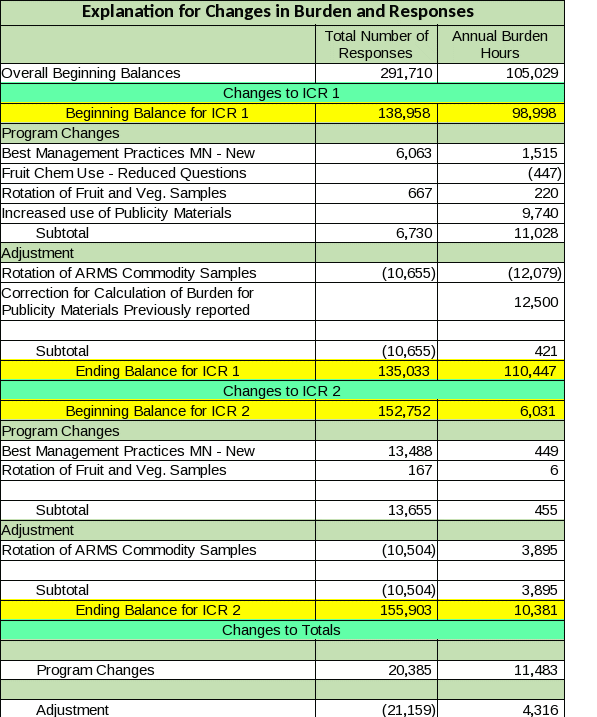

Tabulation, analysis, and publication plans.
The changes to the questionnaires will be incorporated in the publications that are listed in the original approval docket.
For the new, 2021 Best Management Practices survey:
Survey design January - March 2021
Sample selection May 2021
Questionnaire design March - April 2021
Mail Survey July - August 2021
Phone Follow-up August - September 2021
End of Data Collection September 2021
Publication Summer, 2022
Request for approval of non-display of expiration date.
No request is being made for approval of non-display of the expiration date.
18. Exceptions to certification statement.
No exceptions to the certification statement are requested.
May 2021
| File Type | application/vnd.openxmlformats-officedocument.wordprocessingml.document |
| Author | HancDa |
| File Modified | 0000-00-00 |
| File Created | 2022-06-22 |
© 2026 OMB.report | Privacy Policy